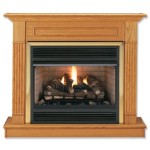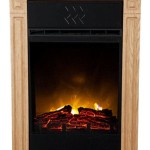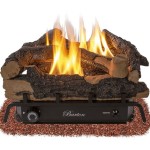How To Decorate A Small Living Room With a Fireplace In The Middle
Decorating a small living room with a centrally located fireplace presents a unique set of challenges and opportunities. The fireplace, while often a focal point and desirable feature, can disrupt the flow and limit furniture arrangement options in a smaller space. Successful design balances functionality, aesthetics, and efficient use of limited square footage. Effective strategies incorporate clever furniture placement, strategic color palettes, and thoughtful accessorizing to create a comfortable and visually appealing living space.
The central fireplace inherently divides the room, creating two distinct zones. This division can be advantageous if used strategically, allowing for the creation of separate seating areas or the delineation of a conversation space from a reading nook. However, it also necessitates careful consideration of sightlines, traffic flow, and the overall sense of spaciousness. Overcrowding the space with bulky furniture or dark colors can exacerbate the feeling of confinement, while a well-planned layout can maximize the perceived and actual space available.
Before embarking on any decorating project, it is crucial to assess the architectural style of the fireplace itself. Is it a traditional brick fireplace, a modern concrete structure, or a rustic stone feature? The existing style will heavily influence the choice of furniture, accessories, and overall decorating scheme. A mismatch between the fireplace's style and the chosen decor can create a jarring and disjointed aesthetic. Furthermore, considering the fireplace's functionality is essential. Is it a working fireplace, or is it purely decorative? If it is a working fireplace, safety considerations and adequate clearances around the structure must be prioritized.
Optimizing Furniture Placement Around a Central Fireplace
Furniture placement is paramount when decorating a small living room with a central fireplace. The goal is to create a functional and inviting space that maximizes seating while maintaining a sense of openness and flow. The most common approach is to arrange seating around the fireplace, creating a conversational grouping. However, in a small space, a traditional sofa facing the fireplace may not be the most space-efficient solution.
Consider alternatives to a large sofa, such as a loveseat or a pair of smaller armchairs placed opposite each other. These configurations allow for comfortable seating without overwhelming the room. Angular placement of furniture can also create a more dynamic and visually interesting layout, breaking away from the rigid symmetry that often characterizes small spaces. For instance, positioning a loveseat at an angle to the fireplace can open up the room and provide better access to other areas.
Utilizing the space behind the fireplace is another often overlooked opportunity. If the fireplace is not flush with the wall, the area behind it can be used for shelving, storage, or even a small desk. Bespoke shelving units can be custom-built to fit the space, providing valuable storage without encroaching on the main living area. Alternatively, a console table or a slim bookcase can be placed behind the fireplace to add visual interest and display decorative items.
When selecting furniture, prioritize pieces with clean lines and a streamlined silhouette. Avoid bulky or overly ornate furniture that will visually weigh down the space. Look for furniture with exposed legs, which creates the illusion of more space underneath and allows light to flow through. Multi-functional furniture, such as ottomans with storage or coffee tables with lift-top mechanisms, are also excellent choices for maximizing space and functionality.
Rugs play a critical role in defining the seating area and grounding the furniture arrangement. A rug that is large enough to encompass all the main pieces of furniture will create a cohesive and unified look. Conversely, a small rug that appears to "float" in the middle of the room can make the space feel disjointed and unbalanced. Choose a rug with a pattern or texture that complements the overall decor and adds visual interest without overwhelming the space. Lighter colored rugs can also enhance the feeling of spaciousness.
Finally, consider the traffic flow around the furniture. Ensure that there are clear pathways for navigating the room without bumping into furniture or feeling constricted. Avoid placing furniture in doorways or obstructing walkways. A well-planned layout will prioritize both comfort and functionality, creating a living room that is both inviting and easy to use.
Employing Color and Lighting to Enhance Space
The choice of color palette and lighting significantly influences the perceived size and atmosphere of a small living room with a central fireplace. Lighter colors tend to reflect more light, making the space feel brighter and more open, while darker colors can absorb light and create a more intimate, albeit potentially smaller-feeling, environment. Strategic use of light and color can effectively manipulate the perception of space and enhance the overall aesthetic appeal.
Opting for a predominantly light and neutral color palette is generally recommended for small spaces. Whites, creams, grays, and pastels are excellent choices for walls, ceilings, and large pieces of furniture. These colors create a sense of airiness and make the room feel more spacious. Accents of bolder colors can be incorporated through accessories, artwork, and smaller pieces of furniture to add personality and visual interest without overwhelming the space.
The fireplace itself can be either a unifying element or a contrasting feature, depending on the desired aesthetic. Painting the fireplace the same color as the walls can help it blend in and create a more seamless look, minimizing its visual prominence. Alternatively, painting the fireplace a contrasting color can make it a focal point and add drama to the room. However, be mindful of the overall color scheme and avoid colors that clash or create a jarring effect.
Lighting is critical for creating a warm and inviting atmosphere and maximizing the perceived space. A combination of natural light, ambient lighting, task lighting, and accent lighting is ideal. Maximize natural light by keeping windows unobstructed and using sheer curtains or blinds that allow light to filter through. Install multiple light sources at different levels to create depth and dimension. Table lamps, floor lamps, and wall sconces can add warmth and character to the room, while recessed lighting or track lighting can provide overall illumination.
Mirror placement is another effective technique for enhancing the perception of space. Mirrors reflect light and create the illusion of greater depth, making the room feel larger than it actually is. Placing a large mirror on a wall opposite a window can effectively double the amount of natural light in the room. Alternatively, a strategically placed mirror behind a piece of furniture can create a sense of depth and make the furniture appear to float in the space.
Finally, consider the color temperature of the light bulbs used in the room. Warm white light bulbs create a cozy and inviting atmosphere, while cool white light bulbs provide a brighter and more energizing light. Choose light bulbs that complement the overall color scheme and create the desired mood. Dimmable light fixtures allow for adjusting the brightness of the light, creating different atmospheres for different occasions.
Accessorizing and Decluttering for a Cohesive Look
Accessorizing and decluttering are essential components of decorating a small living room with a central fireplace. A well-curated collection of accessories can add personality and visual interest, while decluttering helps to create a sense of order and spaciousness. The key is to strike a balance between adding personal touches and avoiding overcrowding the space.
Start by decluttering the room and removing any unnecessary items. Get rid of excess furniture, decorative objects, and clutter that is taking up valuable space. A minimalist approach is generally best for small spaces. Focus on selecting a few key accessories that complement the overall decor and add visual interest. A few well-chosen pieces are more effective than a multitude of scattered items.
Artwork can significantly impact the look and feel of a small living room. Choose artwork that complements the color palette and theme of the room. Large-scale artwork can create a focal point and add drama, while smaller pieces can be grouped together to create a gallery wall. Be mindful of the scale of the artwork in relation to the size of the room. Overly large artwork can overwhelm a small space, while overly small artwork can get lost.
Textiles such as throw pillows, blankets, and curtains can add warmth, texture, and color to the room. Choose textiles that are soft and inviting and that complement the overall color scheme. Layering different textures can add depth and visual interest. Use throw pillows to add pops of color and pattern to the sofa or armchairs. A soft throw blanket can add warmth and comfort to the seating area.
Plants can bring life and vibrancy to a small living room. Choose plants that are appropriate for the amount of light in the room. Plants can be placed on shelves, tables, or the floor. Hanging plants can also be a great way to add greenery without taking up valuable floor space. Plants can also help to purify the air and create a more relaxing and inviting atmosphere.
Pay attention to the details, such as the placement of books, candles, and other decorative objects. Group similar items together to create a cohesive look. Use trays or baskets to organize clutter and keep surfaces clear. A well-organized and clutter-free space will feel more spacious and inviting.
Finally, remember that personal touches are what make a living room feel like home. Incorporate items that reflect your personality and interests, such as family photos, travel souvenirs, or handmade crafts. These personal touches will add character and warmth to the room, making it a space that you truly enjoy spending time in. Regularly assess the accessories and rotate them periodically to keep the space feeling fresh and updated.

How To Arrange A Living Room With Fireplace In The Middle 21oak

36 Fireplace Decor Ideas Modern Mantel

46 Stunning Living Room With Fireplace Design Ideas Farm House Family Remodel

Fireplace Design Ideas For Your Home Designcafe

Inspiring Traditional Design Ideas For Your Home Renovation And Decor

How To Decorate A Living Room With Fireplace In The Middle Organized Apartment

Living Room Layouts With Fireplace Tvs Direct Fireplaces

40 Fabulous Fireplace Design Ideas For Any Budget Or Style

Furniture Setup For Square Living Room With Fireplace Google Search Layout Rectangular Rooms Small

48 Adorable And Cozy Neutral Living Room Design Ideas Matchness Com Livingroom Layout Family Rooms Designs








